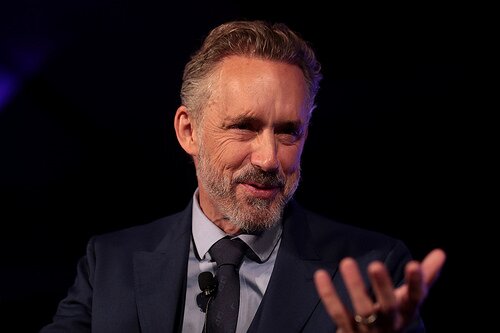Henceforth, we break with the kitschy and safe government-approved forms of Canadian culture. It’s all rebels, mavericks, and misfits from now on. Some of these culture creators are famous and “acceptable”, and still others are infamous and “dangerous”. But they all have one thing in common – Canada was too small to contain them. They were either too talented, too controversial, or both.
Filmmaker David Cronenberg, who we’ll be covering next week, is one of these outsiders who you might have heard of – possibly because The Simpsons parodied one of his films, possibly because of those Rick and Morty episodes which feature body-horror abominations known as Cronenbergs, or because you have used that .gif from Scanners of the balding man whose head explodes. For those who have no familiarity with this wild world, I’ll ease you in with a quick analysis of a group of admittedly strange people you have definitely heard of: the Canadian members of the Intellectual Dark Web.
These are not strictly authors or artists, but they are culture creators. Love him or hate him, Jordan Peterson has impacted the culture significantly, and his inability to fit in with the Canadian mainstream was a major part of that. Even hardcore Peterson acolytes often forget that the Professor only rose to prominence because he opposed a bill that would enshrine gender identity in Canadian hate-crime and human rights law,
When I first came to know of Peterson as a student at the University of Toronto, I quickly learned he had a reputation within the University of Toronto’s Department of Psychology as someone who was not content to merely teach at the self-styled “Harvard of the North.” This was a man who was “a maverick.” He would not “constrain and self-monitor.” He “presented conjecture as a statement of fact.” He did not seem to understand – or perhaps he understood all to well – that his real job, the one his superiors wanted him to do, was to protect U of T’s standing, and to raise its profile, rather than his own.
So, when he became a culture warrior and a household name, and people were reacting to his odd mannerisms and voice, his strange taste in clothes, the way he would describe a scene from Disney’s Pinocchio with the same intensity as you would narrate the final moments of the Super Bowl, I found it all very underwhelming because he might as well have been Pamela Anderson, or Robin Thicke, or Justin Bieber: a celebrity who attained celebrity because he was just weird enough as a Canadian to capture the popular imagination. What was coming out of his mouth was secondary.
To some, Professor Peterson is considered to be the authority on… basically everything, from child psychology to dietary advice to Canadian politics. This is because he fills the role so many Canadian public figures do: that of the blank slate, onto which his adherents project their hopes and desires. So, too, Lauren Southern is both alt-right fantasy and libertarian figurehead. Gavin McInnes is the clownish drunken hipster, cooly transgressive entrepreneur, and mastermind of the Proud Boys. Even Stephen Harper, former Canadian Prime Minister, has been by turns a radical advocate of decentralization, a bailout-loving Keynesian and an authority on populism who of late can be found guesting on Ben Shapiro’s Sunday Special.
It is my belief that this dichotomy – which I’ve touched on already in my discussion of Spawn and Wolverine– between awesome power and crippling weakness, between striking artistic originality and clumsy ham-handedness, and above all, chaos over order, is the defining characteristic of the Canadian culture creator. Canada produces talented filmmakers, but none would ever be mistaken for Spielberg, Fellini, Eisenstein or Kurosawa, and we will see this is the case for creators across music, video games, theatre and in sport (except, of course, for hockey, but even there we will find a few caveats).
********
See the previous installments in the series:
Part 1 on Heroes: ‘Scott Pilgrim Vs The World’ Vs Terrance Denby and ‘Sidequest’
Part 2 on “Humour”: The Libertarian Fantasy of ‘Letterkenny’
Part 3 on Graphic Novel Nihilism: The Harsh Truths of ‘Essex County’
Part 4 on Spawn and Wolverine: Banished From The Promised Land: A Tale of Two Canadian Anti-Heroes
Part 5 on Science Fiction Dystopias: Inside Quebec’s – and Canada’s – Replicant Culture
Part 6 on Animation: The Garrison Mentality: More Than Meets The Eye
Part 7 on Pop Music: How To Build A Successful Canadian Musical Act
Part 8 on Anne of Green Gables and The Traumatized Artist: Lucy Maud Montgomery’s Treacherous Alpine Path
Part 9 on Avoiding the Serious: Mordecai Richler, Montreal, And Gritty Realism
Part 10 on Southern Ontario Gothic: The Marriage of the Mundane and the Fantastic
Part 11 on Margaret Atwood’s Reign of Terror: Literary Tyranny and The Handmaid’s Tale
Part 12 on the First Nations Fraud: Whitewashing Genocide: Truth, Lies, and Joseph Boyden
Part 13 on the inventive Esi Edugyan: A Novel I Cannot Recommend Enough
Part 14 on Douglas Coupland and the Hopeful Future of Canadian Culture: Generation X Origins
****
Photo by Gage Skidmore 



Comments
Leave a Reply